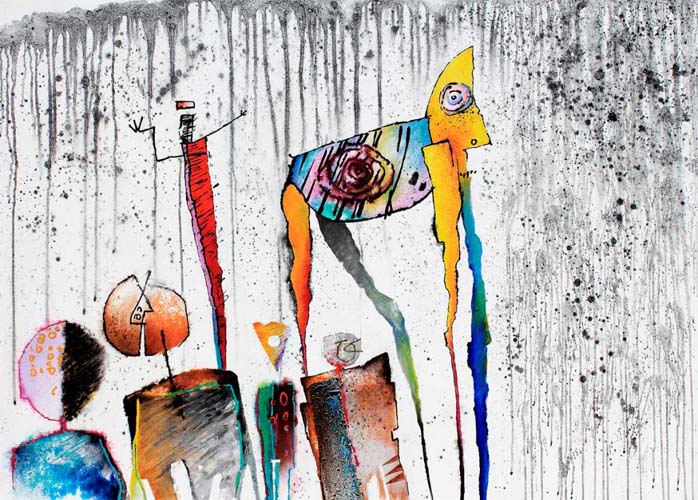
The current solo exhibition at Raw Space Gallery in downtown Vero features the works of Colombian painter Alejo Santa Maria, whose background is as intriguing as his art.
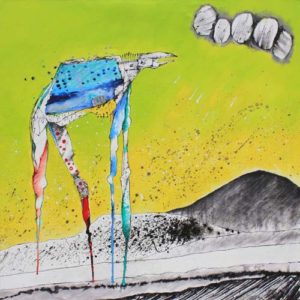 The Colombian artist contacted Silvia Medina, curator of exhibitions for Raw Space, two years ago because he wanted to promote his work in U.S.
The Colombian artist contacted Silvia Medina, curator of exhibitions for Raw Space, two years ago because he wanted to promote his work in U.S.
Santa Maria has shown mainly in Colombia, where he keeps a home and studio on an avocado plantation in Rionegro. The small city is located in the central mountain range of the Andes in eastern Antioquia, a governmental department of Colombia. Apart from his international travels, the 71-year old artist has spent his life in that ruggedly picturesque region. Santa Maria’s record of solo exhibitions in Colombia goes back to 1973. Examples of his work have been included in several group shows in Europe.
The show at Raw Space, on view through Oct. 28, features a colorful display of large, wall-mounted paintings, free-hanging banners, and painted mixed-media sculptures.
Titled “On the Other Side of Memory,” Santa Maria’s Raw Space exhibition highlights paintings from his Carnaval Series. Created in 2014 and 2015, the works are executed on bright white canvases flooded, here and there, with grainy graphite washes. Their ethereal grays are bounded by translucent areas of intense pure color; both are overlaid with significant passages of pen and ink drawing. The viewer who examines the paintings at length will find light touches of pencil that appear – like secret messages —among agitated contour lines and passionate splashes of pigment.
The figures that populate Santa Maria’s compositions are a mix of elemental depictions of the human form inspired by the ancient petroglyphs of Colombia and more recently of the Southwestern U.S.; the frenzy of Carnival revelers in Latin America; and the beings that inhabit the mythologies of Colombia’s native peoples.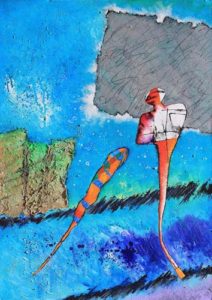
And then there are the animals – specifically, the bird-like and lizard-like creatures that take center stage in three of the paintings on display. “Carnaval 1864” depicts a rainbow-colored animal with a Saul Steinberg profile and long spindly legs; “Gigantonas” features a bird’s head atop a blocky, armless red torso. “Universo sin sol” – perhaps the most memorable work in the exhibition – is the only painting here whose composition holds a lone protagonist. That creature is a stout, hairy abomination with a set of pliers for jaws and four overlong legs that terminate in tiny bulbous feet. It is shown tottering along in a barren landscape whose acid sky holds a single, strangely segmented form.
Also on display are a couple of small works on paper, along with two figural sculptures that look as though they could have stepped out of one of the paintings in the show. But that’s not all; in the southeast corner of the room six vertical banners digitally printed with details from the paintings hang freely from the ceiling trusses to the floor; a seventh textile print is casually draped over an armchair in the center of the room. Each of the photographically-generated banners was produced in a small edition. Santa Maria says that he originally intended the banners to be used as decorative throws or wall hangings; their current installation at Raw Space is the first time a group of them have been displayed in a spatial configuration.
Santa Maria was born in Medellín, Colombia, to a family attuned to the beauties of science and art. Its members included his father Roberto, who was “an excellent photographer,” says Santa Maria.
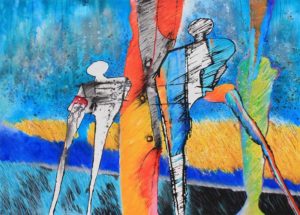 “He guided me in the world of the visual image, especially black and white photography and the magic of the photographic laboratory.”
“He guided me in the world of the visual image, especially black and white photography and the magic of the photographic laboratory.”
From his uncle, a painter also named Alejo, Santa Maria “learned the world of color, shades, tones and how to prepare canvases.”
Santa Maria’s extended relations include artist Andrés de Santa Maria (1860-1945), one of the best-known Colombian painters of his time. Andrés eschewed the banking career that his well-connected father envisioned for him in favor of studying art in Paris. Highly influenced by French Impressionism, Andrés de Santa Maria brought the techniques and subject matter of that movement back to Colombia after years of personal success abroad.
Unlike Andrés, Alejo Santa Maria’s work is primarily influenced by the art and lore of his native Colombia, especially of those native peoples who remain on reservations in Colombia’s Sierra Nevada de Santa Marta mountain range. Also influential to his art are the rich cultural objects and sites left behind by the pre-Columbian cultures of the Americas.
That is not to say that Santa Maria scorns the art of the Western world. The pictures in the current exhibition bear traces of European modernism à la Picasso and Miró, with a pinch of Dalí thrown in (those spindle-shanked beasts).
Santa Maria’s love for the vibrant natural world of Colombia began in childhood.
As a teenager, he attended secondary school at the San José School in Medellín. Founded by the De La Salle Brothers, a Catholic teaching order, the school boasted “one of the best” natural science museums in the country, according the Santa Maria. It also had Brother Daniel de la Inmaculada, a noted Colombian scientist, intellectual and educator, on staff.
“Brother Daniel’s recount of the latter Cenozoic Era, and those beings that lived on this planet, may have been the start of my exuberant imagination,” says Santa Maria.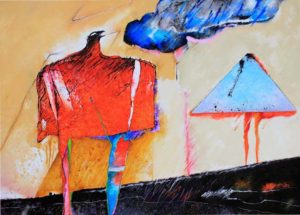
Santa Maria entered Medellín’s prestigious EAFIT University in 1967 to study business administration. His career as a student ended after he spent some time as an exchange student in England.
“I made the following reflection: my real passion is in creating and in the world of art. My teachers shall be the museums of Europe, rather than the experience of working from an office in the world of business.”
Unlike his famous relative Andrés, Santa Maria’s parents were supportive of their son’s decision to quit school to travel and paint.
“They probably understood that business was not my thing,” he says.
Santa Maria found his métier in the mid-1980s when he worked as an artist for Corporación Murundúa, a non-governmental organization in Colombia that sought to assist the native Kankuamo people of Colombia’s Santa Marta mountains in their struggle to keep their ancient culture alive.
In addition to focusing on the management of natural resources in the people’s sacred homeland, the organization helped stimulate the revival of traditional Kankuamo music and handicrafts.
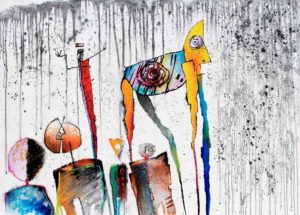 Santa Maria, who worked with the project for 10 years, gained first-hand experience of the culture and cosmography of that isolated people, “in particular with the shamans,” from whom he learned about sacred beings and symbols, especially birds. A few years later Santa Maria went on to produce and film a documentary video, “Songs and Stories of Sacred Birds,” that recorded the lore af another mountain people, the Wiwa.
Santa Maria, who worked with the project for 10 years, gained first-hand experience of the culture and cosmography of that isolated people, “in particular with the shamans,” from whom he learned about sacred beings and symbols, especially birds. A few years later Santa Maria went on to produce and film a documentary video, “Songs and Stories of Sacred Birds,” that recorded the lore af another mountain people, the Wiwa.
His most recent research has taken Santa Maria to the Kykotsmovi village in Northern Arizona, whose Hopi elders shared with him their traditions and stories. He also visited Hotevilla, sacred to the ancient Anasazi, who painted and etched thousands of glyphs onto the rocky landscape.
“They have inspired me to create these imaginary characters that inhabit my exhibition in Vero Beach,” he notes.
Raw Space Gallery is at 1795 Old Dixie Highway.



